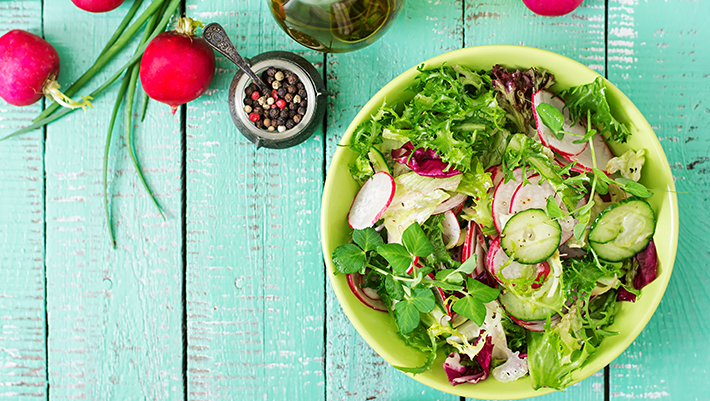
Find out more about it
From a nutritionist’s perspective fibre is one of the most important nutrients there is, but it doesn’t get nearly as much attention as sugar, or the very trendy protein. So I’m here to give you the low-down on why fibre’s so important; why it plays a big role in health; and how to get enough in your diet.
What the heck is fibre?
Well, fibre is defined as the indigestible portion of plant foods; this means that foods like meat, dairy, eggs and fish don’t contain any fibre at all. Most people think that fibre comes from fruits and vegetables, which is absolutely true, but the foods that contain the most fibre are whole grains like oats, barley, rye, and whole wheat. Plus nuts and seeds are great sources of fibre too.
Are there different types of fibre?
There are actually lots of different types of fibre, but the two main types are soluble and insoluble fibre.
Soluble fibre: this type of fibre dissolves in water in your digestive system to form a gel. It may help to reduce the amount of cholesterol in your blood.
Good sources of soluble fibre include:
- oats, barley and rye
- fruit, such as bananas and apples
- root vegetables, such as carrots and potatoes
- golden linseeds/flaxseeds
Insoluble fibre: This type of fibre doesn’t dissolve in water; it passes straight through your gut without being broken down or digested and helps push other foods through more easily. Insoluble fibre keeps your bowels healthy and helps prevent digestive problems. BUT, if you have diarrhoea, you should limit the amount of insoluble fibre in your diet.
Good sources of insoluble fibre include:
- wholemeal bread
- bran
- cereals
- nuts and seeds (except golden linseeds/flaxseeds)
How much fibre do I need?
In 2015 the Scientific Advisory Committee on Nutrition (SACN) reviewed all the scientific evidence on fibre and decided there was enough evidence to increase the recommended intake of fibre from 25g per day to 30g per day from insoluble and soluble sources. However, the National Diet and Nutrition Survey revealed that the average Briton only eats 18g of fibre per day. Around 80% of the population don’t eat enough fibre!
So what’s the big deal?
You might think, “fibre’s not that important; why should I care?” And it’s pretty simple. Fibre helps reduce our risk of major diseases. It’s kind of a big deal! For every additional 7g of fibre we have in our diets every day we reduce the risk of:
- Cardiovascular disease and heart attacks by 9%
- Stroke by 7%
- Type 2 diabetes by 6%
- Colo-rectal cancer by 8%
How does it work?
Different types of fibre work in slightly different ways, which is why it’s important to get a wide variety of different plant foods to make sure you get a good balance of soluble and insoluble fibre.
It’s not super glamorous, but fibre helps keep us regular, bulks out our poop; and foods high in fibre are digested more slowly meaning you don’t get a huge blood sugar spike followed by a massive crash.
Fibre also feeds the healthy bacteria we have living in our gut so they can produce beneficial compounds like vitamins and short chain fatty acids which keep our guts healthy.
How can I get more fibre in my diet?
Base your meals on starchy carbohydrates like whole grain bread, pasta, and baked potatoes. To give you some idea of how to reach your 30g per day, here are some common foods and their fibre count.
Brown rice has 2 grams per serving while white rice only has 1g
A 40g portion of porridge has 4g of fibre
White bread has 1g of fibre and brown bread has 2g
Beans, legumes, and pulses are also great for adding fibre to your meal – for example, a chickpea or lentil curry with brown rice
A 100g portion of lentils or chickpeas contains 6g fibre, and 100g of kidney beans contains 8g of fibre ( beans also count as one of your 5-a-day!)
A sweet potato has 3g of fibre and counts as 1 of your 5- a-day
A medium portion of quinoa (172g cooked) has 6g of fibre
A medium apple has around 1g of fibre
Two slices of rye bread have around 3g of fibre
2 Weetabix have 4g of fibre
A 45g bowl of bran flakes has 7g of fibre – add a sliced banana to top it up to 8g
An 80g portion of peas has 4g of fibre
An 80g serving of carrots (I medium carrot) + 2 tablespoons of hummus contains around 5g of fibre
 Mindful Sodexo
Mindful Sodexo 
0 Comments